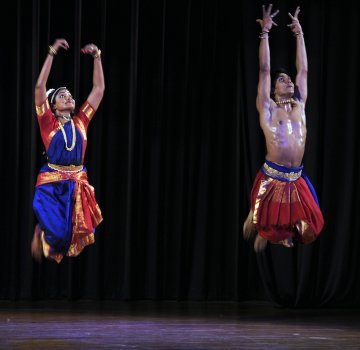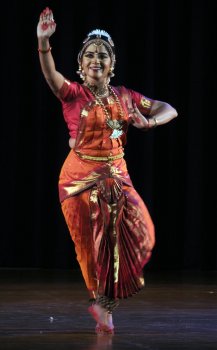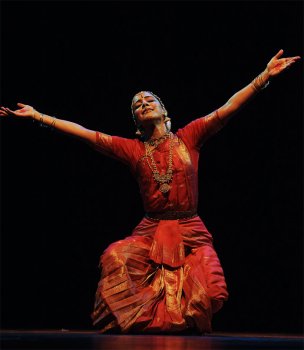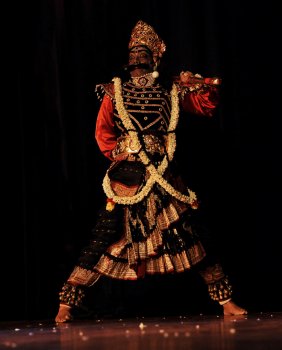
|   |

|   |
Music Academy Dance Festival: Day 4 - Veejay Sai e-mail: vs.veejaysai@gmail.com January 20, 2014 United by their Art Dancer couples and dancing couples come with their own set of idiosyncrasies. Often they act up on the stage for all of the audience to witness. We have seen couples where one of them falters or the other is too brilliant. We have seen couples where one bullies the other and many more couples where both are equally terrible and are made for each other in their collective catastrophe. A couple that balances their energies, art and feeds on their strengths is rare to come by, especially among the younger dancers. Renjith Babu and Vijna Vasudevan belong to the new generation set of artistic couples that are here to stay and pursue their art for all of us to enjoy. Opening the fourth day morning performances at the Academy’s dance fest, both of them impressed the audience with their collective effort.  Vijna and Renjith
Photo: Thanthoni Opening their recital with an invocatory piece in ragam Navarasa Kanada, the first thing one noticed about the couple was a well-coordinated chemistry in their movements. This was followed by the main item, the famous “Chalamela” varnam in ragam Nattu Kurinji. While both of them danced with much energy to Guru C.V. Chandrasekhar’s nattuvangam, the choreography turned out to be a tediously confusing one. He faced the audience and danced and she faced him giving us a profile to view. Too many paths crossing in the movement marred the choreography. When they faced the audience together, they ended doing the same thing over and over again. If the whole point of performing the dance was to mirror each other, how was it any different if there were one or two dancers on stage? Added to this was the singer Nandakumar’s blurring of the sahityam. In the second half, the choreography was better than earlier. As Nandakumar sang “Nannu brova neeku bhaarama,” Renjith and Vijna successfully incorporated the famous Draupadi Vastrapaharanam into the dance. They seemed a bit self-conscious of each other in the treatment they gave this varnam. If they can re-do the choreography and put in a little more thought into their sancharis in the first half, they can easily claim this varnam as a regular part of their performances. The show continued with a solo act by Vijna performing the famous Tirupathi Narayanaswamy javali “Vagalaadi bodhanaku” in ragam Behag. The piece opened with a brilliant aalapam on the violin by Easwar Ramakrishnan, setting us all into the mood of the ragam. While the singer blurred the lyrics in his rendering, Vijna ended up being a little too obvious in her portrayal of the nayika. Studying the language, the deeper significance and the nuances of the sung word would help enhance this piece beyond the current version. Vijna can certainly work on improving her abhinayam. Sruthi Sagar’s playing around with both the madhyamam’s in the ragam was exceptional and evocative. Over the years we have all seen various dancers attempt the famous Papanasam Sivan composition “Idathu padam thooki aadum.” Very few have or possibly can manage the rigorous control over their body in this piece like Renjith Babu can. In the current piece, Renjith stunned everyone with his performance. More than the ragam Khamas in which this piece was composed or his guru C.V. Chandrasekhar’s choreography, what stood out was the visual element in Renjith’s dance. The couple concluded their performance with a Surdas bhajan “Bhoojath Shyam” the music of which was composed by their guru. With good chemistry between the two, the playful elements of the bhajan were highlighted in the choreography. Sruthi Sagar’s flute added extra beauty to the rendering. Renjith and Vijna are a couple made for each other and united in art. We hope they keep their persistence for quality going and continue to enthrall us under the guidance of their guru. Pining Nayikas and Dripping Kohls The mid-morning recital on the fourth day of the festival was by Ragini Chandershekar. A student and daughter of Guru Jamuna Krishnan, Ragini is from Delhi.  Ragini Chandershekar Photo: Thanthoni After a brief invocation in ragam Nattai set to sankeerna chapu talam, Ragini presented her main piece, the famous Tanjore Quartet varnam “Mohamana” set to roopaka talam. This varnam is not new, nor is the story of it. Over the years, various dancers have attempted all kind of choreographic interpretations to its lyrics. Ragini’s performance at its best was a predictable monotonous affair. Putting together a completely frontal presentation in lines that demand more work like “Naagarigamaana thirunagaril vaasare,” one saw Ragini hesitate about using the excellent space she had, all for herself. The nayika’s repetitive sancharis would have bored the lord she was pining for, with so much rehearsed passion. Added to her burning infatuation was the dramatic element when the khol in Ragini’s eyes started dripping down her right cheek, leaving long black tear-lines below her eyes. By the end of the varnam, Ragini’s face was in total disarray. Even if the good lord had decided to visit this nayika by coercion, he would have fled. While performing on such a prestigious platform in a festival most sought after by every dancer in the country, couldn’t she have been a little more cautious with her aharyam and make-up? It is no rocket science to know that actors apply waterproof make-up even for high school dramas. Why did Ragini do this to herself? The saving grace was the nattuvangam by Jayasri Ramanathan and the vocal support by Sudha Raghuraman who didn’t wander off into her own singing on the side and kept her brighas under control. In the Kshetrayya padam “Evvade nenu pavvalinchinavela” Ragini performed next, her abhinayam had little to do with the lyrics of the composition. Performing strongly rehearsed lines one could make out how the dancer was cut off from internalizing the sung word and its meaning. The only solace was to enjoy the beauty of ragam Shankarabharanam on Sigamani’s violin and Raghuraman’s brilliant flute. Jamuna Krishnan is a guru and scholar with much erudition. Having worked extensively in the field of classical literature, she tuned the poems of the legendary Maithili poet Vidyapati and introduced them into Bharatanatyam. The current one Ragini performed was set to ragam Yamuna Kalyani. While there is a certain charm about Ragini’s long-winded dance, one would prefer seeing her put in a little more energy into her performance. This wasn’t the best of what Ragini could perform. We will wait and watch for her to return with more vigor in her dance. With a guru like Jamuna, we know Ragini will give it the best shot! Bonding with the Bindi Mythili Prakash’s evening recital was one that everyone eagerly looked forward to for various reasons. Dancer friends to show support, enthusiastic audiences to witness one of the next generation stars and others out of sheer curiosity to see her performing after a long gap, all the reasons were valid and Mythili gave us a fantastic show. Of course! Nothing less was expected from her!  Mythili Prakash Photo: Siddharth Chandrasekar She commenced her performance with the famous Shiva Panchakshara Stotram. Standing under a spotlight at the far end of the stage, her dance choreography compared the five syllables of the Na, Ma, Shi, Va and Ya to the five elements. Her portrayal of lord Shiva as the core strength on which the universe and the five elements dwell was highly creative. Added to this was the excellent vocal support provided by her brother Aditya Prakash who has gotten better in projecting his baritone voice from the last time we heard him. Mythili continued her performance into her main piece, the Tanjore Quartet varnam “Saami ni Rammanave” in ragam Khamas. With a meditative involvement in her performance, Mythili took us through the story of the nayika. At some point in her performance, the bindi stuck to her forehead went crooked. It would have all been fine if she had just plucked it off and thrown it aside and continued her performance. Instead, at a point when no one would have objected and just about everyone in the hall was getting involved into her performance, she decided to remain distracted with the bindi. This broke the spell and the faulty bindi became a point of unnecessary attraction instead of her performance. Thankfully this was short-lived and Mythili moved into the second half of the varnam with much ease. In the second half of the varnam, even Aditya seemed to have got carried away into a phase of unnecessary ornamentation of swaras after singing “Raave naa maata vinu raave.” Easwar Ramakrishnan’s melodious violin was enjoyable. Mythili continued her performance into a Meera bhajan “Jo tum thodo piya” set to tune by Aditya into ragam Dvijawanthi. Considering the mellow mood of the composition, the uneven beat didn’t fit well. It hurried the whole performance. This is a wonderful piece for abhinaya and if reworked to a slower beat cycle, could help Mythili do wonders on the stage. After a thillana by Dwaraki Krishnaswamy in ragam Valachi, Mythili concluded her performance with a bhajan dedicated to the late singer Lakshmi Shankar with whom she and her family have shared a long bond of friendship. “Dehi muraare kunja bihari” touched a soulful note and reminded one of the innumerable wonderful songs Lakshmi Shankar made popular in her long and illustrious life. For those of us who have seen Mythili perform, this wasn’t one of the best performances. A strong sense of distraction and hurry were obvious. We hope she returns to her earlier serene avatar and continues to enthrall us with her excellent dance. An ode to theatricality The last show for the day was a highly abridged version of ‘Sati Savitri’ by the world famous Sri Lakshmi Narasimha Jayanti Bhagavata Mela Natya Nataka Sangam from Melattur. More popular simply as ‘Melattur Bhagavata Mela,’ the organization was established in 1938 and has been performing year after year, ever since. As an all-male drama troupe, they specialize mostly in presenting stories from mythology and folklore.  S Kumar in Sati Savitri Photo: Siddharth Chandrasekar The story of Sati Savitri is not an unknown one to connoisseurs of Indian art. What was excellent about this show was the genuine attempt the group made to give the best of what they could do, given the conditions of the time and space. It might have been an arduous task to completely pluck them out of their own ambiance, context and time and expect them to edit the play to suit urban audiences. It is no easy task to complete twelve acts, a prelude Poorva Ranga and an afterword Phalasthuthi, all an hour and half span, going by the magnitude of their large-scale productions they normally do. All the various elements of theatre including daruvus, dwipadhas, vachanams, kandhams, slokams and more were intricately woven into the entire narrative. Noteworthy were the excellent musicians and their orchestra that kept the whole narrative together. Utilizing a mélange of ragams, talams and infusing them into the theatrical element to keep it as close to the original must have been a massive task. The costumes and make up that looked very much like old world calendar art was a visual delight to see. Exceptional were the roles played by Srikant Natarajan as queen Maanavi and S. Kumar as Yama. From songs of the royal couple praying for a child like “Nera nammitini neeve gati ani, Nikhila loka paripaalini Savithri” to the other Vivaha Kalpanamu, it was a delight to listen to the entire sing-song operatic traditions as they traversed various ragams, all with a very literary Telugu language that isn’t commonly spoken today. Though they shot well past their allotted time, it was a sheer visual and aural delight to watch them perform. More power to them for sustaining this difficult art form and preserving it for posterity! Veejay Sai is a writer, editor and a culture critic. He is the official reviewer of the Madras Music Academy’s annual dance festival. |